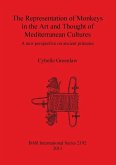Jill Pruetz
The Socioecology of Adult Female Patas Monkeys and Vervets in Kenya
Jill Pruetz
The Socioecology of Adult Female Patas Monkeys and Vervets in Kenya
- Gebundenes Buch
- Merkliste
- Auf die Merkliste
- Bewerten Bewerten
- Teilen
- Produkt teilen
- Produkterinnerung
- Produkterinnerung
"The Role of Assessment in Schools" looks at the conceptual aspects of tests and testing and also gives practical guidelines on how to use tests to their best effect. It considers the development of tests, the types and scope of tests, their application and interpretation, and answers questions on who wants testing, whether the test is appropriate or biased, and whether the results are consistent?.
Andere Kunden interessierten sich auch für
![The Socioecology of Adult Female Patas Monkeys and Vervets in Kenya The Socioecology of Adult Female Patas Monkeys and Vervets in Kenya]() Jill PruetzThe Socioecology of Adult Female Patas Monkeys and Vervets in Kenya58,99 €
Jill PruetzThe Socioecology of Adult Female Patas Monkeys and Vervets in Kenya58,99 €![Female Education and Adult Literacy-Exploring the connection Female Education and Adult Literacy-Exploring the connection]() Sayed Muzaffar Ali ShahFemale Education and Adult Literacy-Exploring the connection32,99 €
Sayed Muzaffar Ali ShahFemale Education and Adult Literacy-Exploring the connection32,99 €![Influence of Economic Marginalization on Adult Female Recidivism Influence of Economic Marginalization on Adult Female Recidivism]() Carolyn DennisInfluence of Economic Marginalization on Adult Female Recidivism32,99 €
Carolyn DennisInfluence of Economic Marginalization on Adult Female Recidivism32,99 €![The Representation of Monkeys in the Art and Thought of Mediterranean Cultures The Representation of Monkeys in the Art and Thought of Mediterranean Cultures]() Cybelle GreenlawThe Representation of Monkeys in the Art and Thought of Mediterranean Cultures50,99 €
Cybelle GreenlawThe Representation of Monkeys in the Art and Thought of Mediterranean Cultures50,99 €![Strengths-Based Practice in Adult Social Work and Social Care Strengths-Based Practice in Adult Social Work and Social Care]() Strengths-Based Practice in Adult Social Work and Social Care178,99 €
Strengths-Based Practice in Adult Social Work and Social Care178,99 €![British-Indian Adult Children of Divorce British-Indian Adult Children of Divorce]() Chaitali DasBritish-Indian Adult Children of Divorce63,99 €
Chaitali DasBritish-Indian Adult Children of Divorce63,99 €![Female Hierarchies Female Hierarchies]() Female Hierarchies112,99 €
Female Hierarchies112,99 €-
-
-
"The Role of Assessment in Schools" looks at the conceptual aspects of tests and testing and also gives practical guidelines on how to use tests to their best effect. It considers the development of tests, the types and scope of tests, their application and interpretation, and answers questions on who wants testing, whether the test is appropriate or biased, and whether the results are consistent?.
Produktdetails
- Produktdetails
- Verlag: Routledge
- Seitenzahl: 192
- Erscheinungstermin: 11. Juli 2017
- Englisch
- Abmessung: 235mm x 157mm x 15mm
- Gewicht: 437g
- ISBN-13: 9781138403741
- ISBN-10: 1138403741
- Artikelnr.: 48950909
- Herstellerkennzeichnung
- Libri GmbH
- Europaallee 1
- 36244 Bad Hersfeld
- gpsr@libri.de
- Verlag: Routledge
- Seitenzahl: 192
- Erscheinungstermin: 11. Juli 2017
- Englisch
- Abmessung: 235mm x 157mm x 15mm
- Gewicht: 437g
- ISBN-13: 9781138403741
- ISBN-10: 1138403741
- Artikelnr.: 48950909
- Herstellerkennzeichnung
- Libri GmbH
- Europaallee 1
- 36244 Bad Hersfeld
- gpsr@libri.de
Dr. Jill Pruetz is Assistant Professor of Anthropology at Iowa State University, specializing in Biological Anthropology. As a primatologist, Dr. Pruetz has studied the behavior of non-human primates such as chimpanzees, spider monkeys, howling monkeys, tamarins, patas monkeys, and vervets in various locales. Countries in which she has conducted fieldwork include Peru, Costa Rica, Nicaragua, Kenya, and Senegal. Dr. Pruetz is especially interested in the influence of ecology on primate and early human feeding, ranging, and social behavior. She currently has a research project in southeastern Senegal which has been funded by National Geographic Society and the National Science Foundation.
CH. 1: The Research Question Study species - Vervets and patas monkeys
Questions and hypotheses Socioecological theory - Food resources and
primate behavior Scramble and contest competition Social dominance Models
of female social relationships Testing the models on Segera: A natural
ecological experiment Holding habitat constant Other factors affecting
female social behavior Project goals revisited Study groups Study subjects
CH. 2. Measuring primate behavior and ecology "Measuring" ecology Measuring
food availability Commonly used methods Primates' perceptions of the foods
available to them Clumped resources and contest competition CH. 3: Foods
available to vervet and patas monkeys Hypotheses and predictions Defining a
food patch Measuring food availability Large-scale food availability
Methods Results Small-scale food availability Methods Results Swollen thorn
foods Foods in the riverine habitat Herbaceous level food availability Food
availability on Segera CH. 4: Feeding behavior of vervets and patas monkeys
Studying the feeding behavior of sympatric species Vervets and patas
monkeys: Expected differences and similarities Whistling-thorn Acacia: Why
focus on one food species? Feeding behavior Continuous sampling Bout
sampling Rank-related differences in feeding behavior Patch depletion
Monkeys, Acacia, and ants Species differences Within-species differences
according to rank CH. 5: Contest competition and dominance in vervets The
concept of dominance Testing hypotheses Results: Contest competition and
dominance in vervets Dominance patterns and feeding competition in vervets
The significance of dominance to vervets Dominance style in Segera vervets
"Typical" cercopithecines? Why a stable, linear dominance hierarchy on
Segera? CH. 6: Comparing vervet and patas monkeys in the same habitat.
Questions and Predictions Agonistic and dominance behavior Food
contestability in vervets and patas monkeys Dominance in adult females
Feeding competition and whistling-thorn foods Significance of feeding
competition to vervet and patas monkeys CH. 7: Food availability, feeding
competition and dominance in vervet and patas monkeys. Female contest
competition and dominance in vervets and patas monkeys on Segera How do the
models rate? Summary and implications for future research
Questions and hypotheses Socioecological theory - Food resources and
primate behavior Scramble and contest competition Social dominance Models
of female social relationships Testing the models on Segera: A natural
ecological experiment Holding habitat constant Other factors affecting
female social behavior Project goals revisited Study groups Study subjects
CH. 2. Measuring primate behavior and ecology "Measuring" ecology Measuring
food availability Commonly used methods Primates' perceptions of the foods
available to them Clumped resources and contest competition CH. 3: Foods
available to vervet and patas monkeys Hypotheses and predictions Defining a
food patch Measuring food availability Large-scale food availability
Methods Results Small-scale food availability Methods Results Swollen thorn
foods Foods in the riverine habitat Herbaceous level food availability Food
availability on Segera CH. 4: Feeding behavior of vervets and patas monkeys
Studying the feeding behavior of sympatric species Vervets and patas
monkeys: Expected differences and similarities Whistling-thorn Acacia: Why
focus on one food species? Feeding behavior Continuous sampling Bout
sampling Rank-related differences in feeding behavior Patch depletion
Monkeys, Acacia, and ants Species differences Within-species differences
according to rank CH. 5: Contest competition and dominance in vervets The
concept of dominance Testing hypotheses Results: Contest competition and
dominance in vervets Dominance patterns and feeding competition in vervets
The significance of dominance to vervets Dominance style in Segera vervets
"Typical" cercopithecines? Why a stable, linear dominance hierarchy on
Segera? CH. 6: Comparing vervet and patas monkeys in the same habitat.
Questions and Predictions Agonistic and dominance behavior Food
contestability in vervets and patas monkeys Dominance in adult females
Feeding competition and whistling-thorn foods Significance of feeding
competition to vervet and patas monkeys CH. 7: Food availability, feeding
competition and dominance in vervet and patas monkeys. Female contest
competition and dominance in vervets and patas monkeys on Segera How do the
models rate? Summary and implications for future research
CH. 1: The Research Question Study species - Vervets and patas monkeys
Questions and hypotheses Socioecological theory - Food resources and
primate behavior Scramble and contest competition Social dominance Models
of female social relationships Testing the models on Segera: A natural
ecological experiment Holding habitat constant Other factors affecting
female social behavior Project goals revisited Study groups Study subjects
CH. 2. Measuring primate behavior and ecology "Measuring" ecology Measuring
food availability Commonly used methods Primates' perceptions of the foods
available to them Clumped resources and contest competition CH. 3: Foods
available to vervet and patas monkeys Hypotheses and predictions Defining a
food patch Measuring food availability Large-scale food availability
Methods Results Small-scale food availability Methods Results Swollen thorn
foods Foods in the riverine habitat Herbaceous level food availability Food
availability on Segera CH. 4: Feeding behavior of vervets and patas monkeys
Studying the feeding behavior of sympatric species Vervets and patas
monkeys: Expected differences and similarities Whistling-thorn Acacia: Why
focus on one food species? Feeding behavior Continuous sampling Bout
sampling Rank-related differences in feeding behavior Patch depletion
Monkeys, Acacia, and ants Species differences Within-species differences
according to rank CH. 5: Contest competition and dominance in vervets The
concept of dominance Testing hypotheses Results: Contest competition and
dominance in vervets Dominance patterns and feeding competition in vervets
The significance of dominance to vervets Dominance style in Segera vervets
"Typical" cercopithecines? Why a stable, linear dominance hierarchy on
Segera? CH. 6: Comparing vervet and patas monkeys in the same habitat.
Questions and Predictions Agonistic and dominance behavior Food
contestability in vervets and patas monkeys Dominance in adult females
Feeding competition and whistling-thorn foods Significance of feeding
competition to vervet and patas monkeys CH. 7: Food availability, feeding
competition and dominance in vervet and patas monkeys. Female contest
competition and dominance in vervets and patas monkeys on Segera How do the
models rate? Summary and implications for future research
Questions and hypotheses Socioecological theory - Food resources and
primate behavior Scramble and contest competition Social dominance Models
of female social relationships Testing the models on Segera: A natural
ecological experiment Holding habitat constant Other factors affecting
female social behavior Project goals revisited Study groups Study subjects
CH. 2. Measuring primate behavior and ecology "Measuring" ecology Measuring
food availability Commonly used methods Primates' perceptions of the foods
available to them Clumped resources and contest competition CH. 3: Foods
available to vervet and patas monkeys Hypotheses and predictions Defining a
food patch Measuring food availability Large-scale food availability
Methods Results Small-scale food availability Methods Results Swollen thorn
foods Foods in the riverine habitat Herbaceous level food availability Food
availability on Segera CH. 4: Feeding behavior of vervets and patas monkeys
Studying the feeding behavior of sympatric species Vervets and patas
monkeys: Expected differences and similarities Whistling-thorn Acacia: Why
focus on one food species? Feeding behavior Continuous sampling Bout
sampling Rank-related differences in feeding behavior Patch depletion
Monkeys, Acacia, and ants Species differences Within-species differences
according to rank CH. 5: Contest competition and dominance in vervets The
concept of dominance Testing hypotheses Results: Contest competition and
dominance in vervets Dominance patterns and feeding competition in vervets
The significance of dominance to vervets Dominance style in Segera vervets
"Typical" cercopithecines? Why a stable, linear dominance hierarchy on
Segera? CH. 6: Comparing vervet and patas monkeys in the same habitat.
Questions and Predictions Agonistic and dominance behavior Food
contestability in vervets and patas monkeys Dominance in adult females
Feeding competition and whistling-thorn foods Significance of feeding
competition to vervet and patas monkeys CH. 7: Food availability, feeding
competition and dominance in vervet and patas monkeys. Female contest
competition and dominance in vervets and patas monkeys on Segera How do the
models rate? Summary and implications for future research









